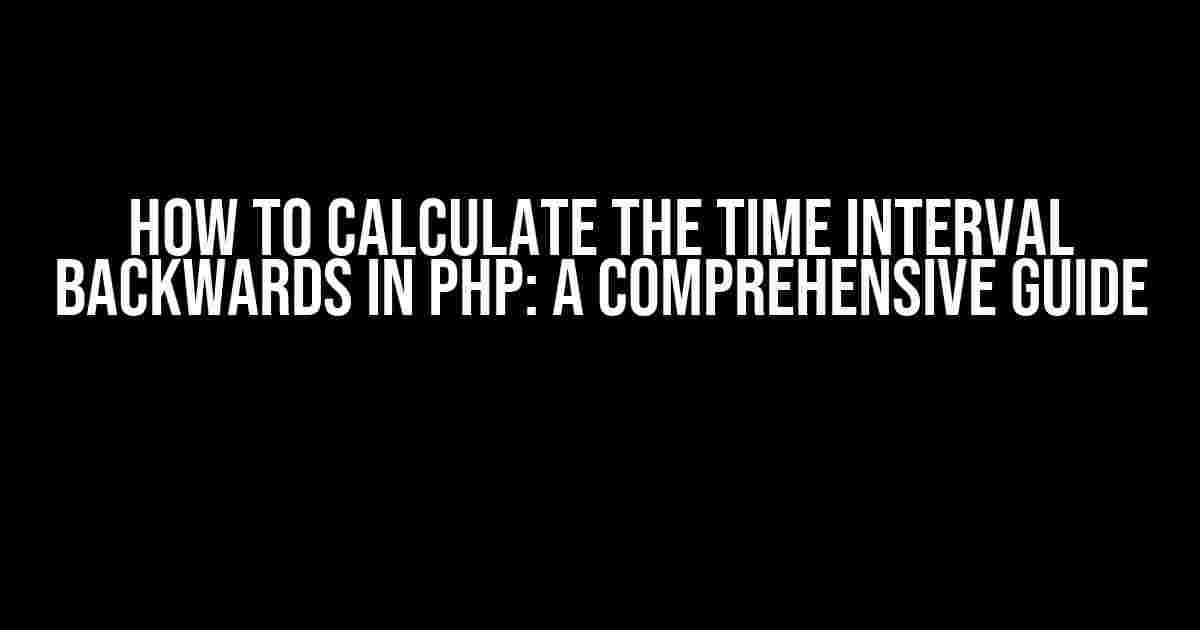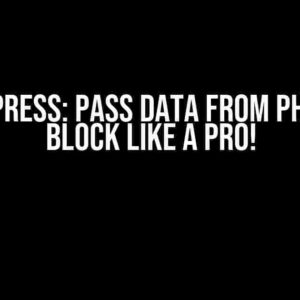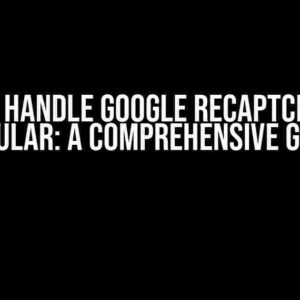Are you tired of getting lost in the complexities of time calculations in PHP? Do you struggle to figure out how to calculate the time interval backwards? Worry no more! In this article, we’ll take you on a journey to master the art of calculating time intervals backwards in PHP. Buckle up, and let’s get started!
What is a Time Interval?
A time interval, in the context of PHP, refers to the difference between two timestamps. It’s the amount of time that has passed between two specific points in time. Calculating time intervals is a crucial task in many web applications, such as scheduling, billing, and analytics.
Why Calculate Time Intervals Backwards?
Calculating time intervals backwards is essential in scenarios where you need to determine the start time based on an end time and a given interval. For example, if you want to find the start time of a 30-day trial period that ends on a specific date, you need to calculate the time interval backwards.
Understanding PHP’s DateTime Class
Before we dive into calculating time intervals, it’s essential to understand PHP’s DateTime class. The DateTime class is a powerful tool for working with dates and times in PHP. It provides a robust and flexible way to manipulate and calculate dates and times.
$date = new DateTime('2022-07-25 14:30:00');
echo $date->format('Y-m-d H:i:s'); // Output: 2022-07-25 14:30:00
Getting Familiar with DateInterval
The DateInterval class is used to represent a time interval in PHP. It’s an essential component in calculating time intervals. A DateInterval object is created using the following format:
$dateInterval = new DateInterval('P' . $years . 'Y' . $months . 'M' . $days . 'D' . $hours . 'H' . $minutes . 'M' . $seconds . 'S');
In the above code, ‘P’ represents the period, followed by the number of years, months, days, hours, minutes, and seconds.
Calculating Time Intervals Backwards
Method 1: Using DateInterval and Sub
This method involves creating a DateInterval object and using the sub method to subtract the interval from the end time.
$endTime = new DateTime('2022-07-25 14:30:00');
$dateInterval = new DateInterval('P30D'); // 30-day interval
$startTime = $endTime->sub($dateInterval);
echo $startTime->format('Y-m-d H:i:s'); // Output: 2022-06-25 14:30:00
Method 2: Using DateInterval and Modify
This method involves creating a DateInterval object and using the modify method to subtract the interval from the end time.
$endTime = new DateTime('2022-07-25 14:30:00');
$dateInterval = new DateInterval('P30D'); // 30-day interval
$startTime = clone $endTime;
$startTime->modify('-' . $dateInterval->format('%R%y years %m months %d days %H hours %i minutes %s seconds'));
echo $startTime->format('Y-m-d H:i:s'); // Output: 2022-06-25 14:30:00
Method 3: Using TIMESTAMPDIFF
This method involves using the TIMESTAMPDIFF function to calculate the time interval backwards. This method is only available in MySQL and is used in conjunction with PHP’s DateTime class.
$endTime = new DateTime('2022-07-25 14:30:00');
$interval = 30; // 30-day interval
$query = "SELECT TIMESTAMPDIFF(DAY, DATE_SUB('" . $endTime->format('Y-m-d H:i:s') . "', INTERVAL " . $interval . " DAY), '" . $endTime->format('Y-m-d H:i:s') . "') AS startTime";
// Execute the query using your preferred MySQL extension
Real-World Scenarios
Example 1: Calculating the Start Date of a Trial Period
Suppose you want to calculate the start date of a 30-day trial period that ends on July 25, 2022.
$endTime = new DateTime('2022-07-25 14:30:00');
$dateInterval = new DateInterval('P30D'); // 30-day interval
$startTime = $endTime->sub($dateInterval);
echo $startTime->format('Y-m-d H:i:s'); // Output: 2022-06-25 14:30:00
Example 2: Calculating the Start Date of a Subscription
Suppose you want to calculate the start date of a 1-year subscription that ends on December 31, 2022.
$endTime = new DateTime('2022-12-31 23:59:59');
$dateInterval = new DateInterval('P1Y'); // 1-year interval
$startTime = $endTime->sub($dateInterval);
echo $startTime->format('Y-m-d H:i:s'); // Output: 2021-12-31 23:59:59
Common Pitfalls and Troubleshooting
Pitfall 1: DateInterval Format
Make sure to use the correct format when creating a DateInterval object. The format should always start with ‘P’ followed by the number of years, months, days, hours, minutes, and seconds.
Pitfall 2: Timezone Issues
When working with dates and times, it’s essential to consider the timezone. Make sure to set the correct timezone for your DateTime objects to avoid errors.
Pitfall 3:Leap Years and DST
Leap years and daylight saving time (DST) can cause issues when calculating time intervals. Make sure to account for these factors when performing calculations.
Conclusion
Calculating time intervals backwards in PHP can be a complex task, but with the right techniques and tools, it can be achieved with ease. By mastering the DateTime and DateInterval classes, you’ll be well-equipped to tackle even the most challenging time calculation tasks. Remember to avoid common pitfalls and troubleshoot your code thoroughly to ensure accurate results.
| Method | Description | Example |
|---|---|---|
| Method 1: Using DateInterval and Sub | Subtract the interval from the end time using the sub method. | $endTime->sub($dateInterval) |
| Method 2: Using DateInterval and Modify | Subtract the interval from the end time using the modify method. | $startTime->modify('-' . $dateInterval->format('%R%y years %m months %d days %H hours %i minutes %s seconds')) |
| Method 3: Using TIMESTAMPDIFF | Use the TIMESTAMPDIFF function in MySQL to calculate the time interval backwards. | TIMESTAMPDIFF(DAY, DATE_SUB('" . $endTime->format('Y-m-d H:i:s') . "', INTERVAL " . $interval . " DAY), '" . $endTime->format('Y-m-d H:i:s') . "') AS startTime |
- PHP’s DateTime Class Documentation
- PHP’s DateInterval Class Documentation
- MySQL’s Date and Time Functions Documentation
With this comprehensive guide, you’re now equipped to calculate time intervals backwards in PHP with confidence. Remember to practice and experiment with different scenarios to solidify your understanding. Happy coding!
FAQs
Q: What is the difference between the sub and modify methods?
A: The sub method subtracts the interval from the DateTime object, whereas the modify method modifies the DateTime object by subtracting the interval.
Q: Can I use the TIMESTAMPDIFF function in PHP?
A: No, the TIMESTAMPDIFF function is a MySQL function and cannot be used directly in PHP. However, you can use it in conjunction with PHP’s DateTime class to
Frequently Asked Question
Cracking the code on calculating time intervals backwards in PHP? You’re in the right place! Here are some frequently asked questions to get you started:
Q1: How do I calculate the time interval backwards in PHP?
To calculate the time interval backwards in PHP, you can use the `strtotime()` function with a negative value. For example, if you want to calculate the time 5 hours ago, you can use `strtotime(‘-5 hours’)`. This will give you the Unix timestamp for the time 5 hours ago. You can then use the `date()` function to format the timestamp as needed.
Q2: How do I calculate a specific date and time interval backwards in PHP?
To calculate a specific date and time interval backwards in PHP, you can use the `strtotime()` function with a specific date and time string. For example, if you want to calculate the time 3 days and 2 hours ago from a specific date and time, you can use `strtotime(‘-3 days -2 hours’, strtotime(‘2022-07-25 14:30:00’))`. This will give you the Unix timestamp for the time 3 days and 2 hours ago from the specified date and time.
Q3: Can I use PHP’s DateTime class to calculate time intervals backwards?
Yes, you can use PHP’s DateTime class to calculate time intervals backwards. The DateTime class provides a `sub()` method that can be used to subtract a time interval from a DateTime object. For example, to calculate the time 1 week ago, you can use `$datetime->sub(new DateInterval(‘P1W’))`. This will subtract 1 week from the current DateTime object.
Q4: How do I calculate the time interval backwards in PHP for a specific timezone?
To calculate the time interval backwards in PHP for a specific timezone, you can use the `strtotime()` function with a timezone string. For example, to calculate the time 2 hours ago in the ‘America/New_York’ timezone, you can use `strtotime(‘-2 hours’, strtotime(‘now America/New_York’))`. This will give you the Unix timestamp for the time 2 hours ago in the specified timezone.
Q5: Can I use PHP’s Carbon library to calculate time intervals backwards?
Yes, you can use PHP’s Carbon library to calculate time intervals backwards. Carbon provides a `sub()` method that can be used to subtract a time interval from a Carbon instance. For example, to calculate the time 4 days ago, you can use `$carbon->subDays(4)`. This will subtract 4 days from the current Carbon instance.





